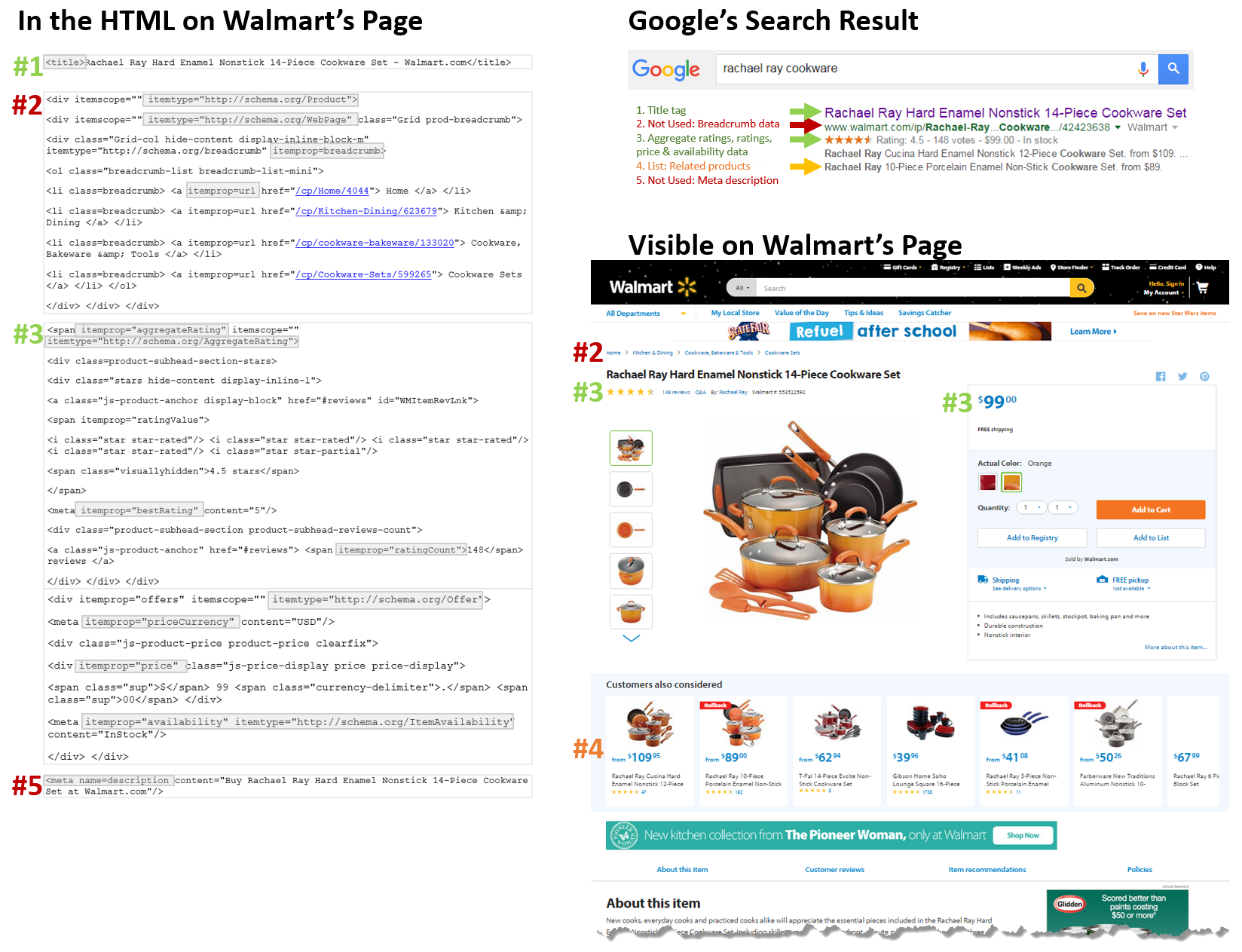Marketers tend to find metadata annoying, like tiny gnats that you’d rather just swat away. Maybe you don’t know where they come from; maybe you don’t know what purpose they serve.
But metadata and structured data are important to improving your click rates from search engines for the queries your site already wins. It’s a way of optimizing your search results so that they are more visually stimulating and data-rich, which in turn draws the searcher’s eye. These optimized search results are called rich snippets, and they may just give you the edge you need to win the click when search result competition is high.
Recently I’ve written two articles about metadata — “SEO: Why Is Metadata Important?” and “SEO: Using Metadata to Drive Traffic.” But these have mostly identified the elements themselves.
Metadata for Walmart.com
Consider this example of how specific data was used to change the way a search result looks for Walmart. You’ve probably seen the little stars and price information in search results. These rich snippet items are a result of metadata, specifically structured data using Schema.org guidelines.
The image below shows a search result (top right), the page that ranks to create that search result (bottom right), and the basic HTML code (left) that influences the information shown in the search result. The pieces of code that contain structured data are highlighted in gray in the code on the left.
I’ve called out five areas of interest in the search result snippet shown above at top right.
1. Title tag. Title tags are an important on-page element in the HTML code that doesn’t display anywhere on the product page itself. As you can see by comparing the code snippet labeled #1 at left with the top line of the search result, labeled “1. Title tag” at right, Google has used the title tag as the blue link. Walmart’s brand has been stripped out of the link text in the search result, likely because the product name is so long that there’s no additional room for site branding.
2. Breadcrumb structured data. Walmart has included structured data around its breadcrumb links, but Google did not choose to use it in its search result. The structured data is shown on the left at #2, wrapped around the existing breadcrumb for the page. The page’s breadcrumb is displayed in Walmart’s page marked by #2 as well. But in the rich snippet, Google is just showing its default URL for the page.
The URL is focused on the product name, so perhaps Google thought it was better to show the URL than the breadcrumb trail to get to the product. The lesson here is that using structured data makes your pages eligible for rich snippets but does not guarantee that the search engines will use them in every search result for every keyword.
The lesson here is that using structured data makes your pages eligible for rich snippets but does not guarantee that the search engines will use them…
3. Ratings, reviews, and pricing. This is the most common form of rich snippets that Google shows for ecommerce sites. Optimizing for rich snippets simply means inserting structured data around the reviews and pricing information that’s already displayed on the page. There’s no change to the way that the information is displayed on the page, but it makes the page eligible to trigger rich snippets in search results.
Look at the areas highlighted gray in the code for #3 above. That code surrounds the regular reviews and pricing information displayed in the Walmart page shown at right, marked with #3 in two places. And Google has picked this information up to use in its search results, showing searchers right on the search results page how well the product is rated and that they can buy it right now. This extra row of rich information takes up a slightly larger piece of the search results real estate and adds a visual element that draws the eye to improve clicks to the page.
4. List content. Sometimes Google chooses to display a couple of related products instead of a description of the page in its search results. This one is interesting because it’s not included as a result of metadata at all; it’s based on inclusion of a very clear list of items in the page.
This is rarely seen in search results for product detail pages, but it’s more common in product listing pages and forum rankings. There’s no code snippet shown at left, because it’s not a result of using metadata like the other examples are. But you can see how the page displays the content shown by #4 in the Walmart page at right, and also in the search result itself.
5. Meta description. The interesting inclusion of the list elements in the search result has eclipsed the spot where the meta description would normally be seen. It’s marked as #5 at bottom left, and not seen at all in the search result or the Walmart page. This is a common fate for meta descriptions, because search engines will frequently choose to display content from the page that appears to be more relevant to the searcher’s query than the meta description.
Write meta descriptions as a default description for search engines to use. If there’s no relevant copy on the page and no meta description to pull in, search engines may resort to cobbling a “description” together from a list of header and navigation words all jumbled together. This happens far less now than it used to, but the meta description protects your pages from that fate.
If there’s no relevant copy on the page and no meta description to pull in, search engines may resort to cobbling a “description” together from a list of header and navigation words all jumbled together.
It’s easier to manage metadata and structured data for SEO when you’ve seen what it looks like and how it works to impact search results. This single example based on a ranking result for a single product page doesn’t expose you to every form of metadata. But the concept for all forms are similar to the five elements shown in this example.
It’s important to use metadata and structured data to be eligible for rich snippets. Your site may not trigger rich snippets for every search query, or even for most, but it’s certain that you won’t receive any rich snippets if you won’t include structured data.





